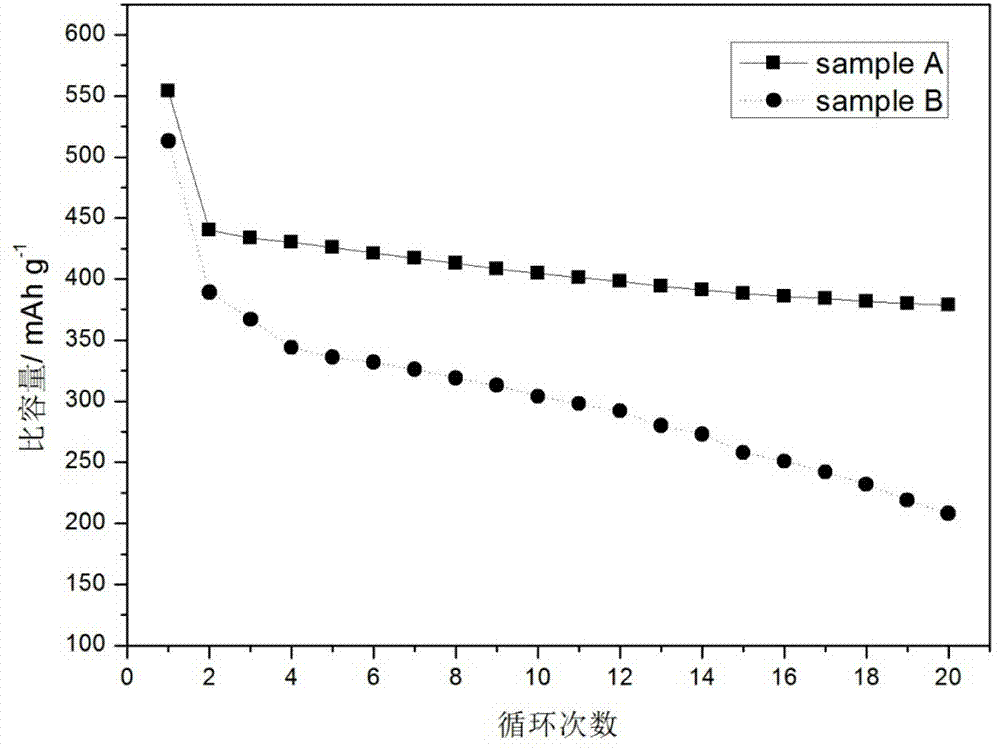Method for manufacturing tin-stibium-nickel alloy cathode material of lithium ion battery
A technology for lithium-ion batteries and negative electrode materials, applied in battery electrodes, circuits, electrical components, etc., can solve the problems that cannot meet the long-term development needs of high-capacity batteries, low strength of nickel foam and copper foam, and are not suitable for high-current discharge, etc. Achieve the effects of reducing battery weight, preventing corrosion, and solving the problem of low copper capacity
- Summary
- Abstract
- Description
- Claims
- Application Information
AI Technical Summary
Problems solved by technology
Method used
Image
Examples
Embodiment 1
[0024] Prepare the tin-antimony-nickel electrodeposition solution, which contains 0.1mol / L of SnCl 4 , 0.1mol / L of SbCl 3 , 0.1mol / L NiCl 2 , 0.1mol / L NH 4 Cl, 0.1mol / L sodium dodecylbenzenesulfonate, adjust the pH=3 of the electrodeposition solution with sulfuric acid.
[0025] Use carbon fiber cloth as the working electrode, graphite as the counter electrode, use the solution prepared above as the electrolyte, and control the current density to 10mA / cm 2 , the temperature is 25°C, and the time is 60 minutes, so that the tin-antimony-nickel alloy layer is plated on the carbon fiber cloth.
Embodiment 2
[0027] Prepare the tin-antimony-nickel electrodeposition solution, which contains 0.3mol / L of SnCl 4 , 0.3mol / L of SbCl 3 , 0.3mol / L NiCl 2 , 0.08mol / L (NH 4 ) 2 SO 4 , 0.08mol / L sodium dodecylbenzene sulfonate, adjust the pH=2 of the electrodeposition solution with sulfuric acid.
[0028] Use carbon fiber cloth as the working electrode, graphite as the counter electrode, use the solution prepared above as the electrolyte, and control the current density to 30mA / cm 2 , the temperature is 50°C, and the time is 30 minutes, so that a tin-antimony-nickel alloy layer is plated on the carbon fiber cloth.
Embodiment 3
[0030] Prepare tin-antimony-nickel electrodeposition solution, which contains 0.5mol / L of SnSO 4 , 0.5mol / L of SbCl 3 , 0.5mol / L NiSO 4 , 0.12mol / L NH 4 HSO 4 , 0.12mol / L nonylphenol polyoxyethylene ether, adjust the pH=1 of the electrodeposition solution with sulfuric acid.
[0031] Use carbon fiber cloth as the working electrode, graphite as the counter electrode, use the solution prepared above as the electrolyte, and control the current density to 50mA / cm 2 , the temperature is 80°C, and the time is 120min, so that a tin-antimony-nickel alloy layer is plated on the carbon fiber cloth.
PUM
 Login to View More
Login to View More Abstract
Description
Claims
Application Information
 Login to View More
Login to View More - R&D
- Intellectual Property
- Life Sciences
- Materials
- Tech Scout
- Unparalleled Data Quality
- Higher Quality Content
- 60% Fewer Hallucinations
Browse by: Latest US Patents, China's latest patents, Technical Efficacy Thesaurus, Application Domain, Technology Topic, Popular Technical Reports.
© 2025 PatSnap. All rights reserved.Legal|Privacy policy|Modern Slavery Act Transparency Statement|Sitemap|About US| Contact US: help@patsnap.com


